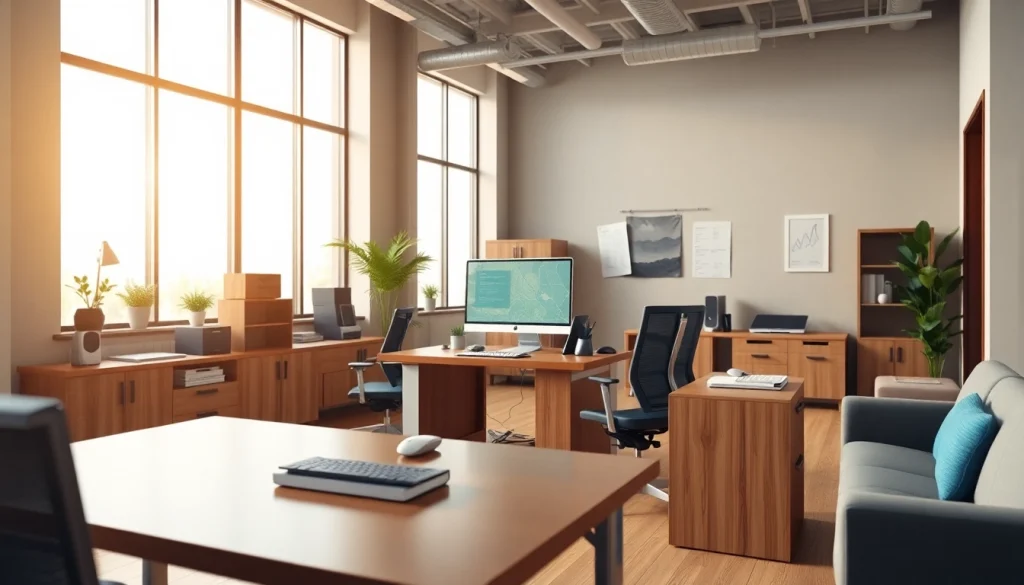Understanding 3D Model Visualizations
What Are 3D Model Visualizations?
3D model visualizations are digital representations of objects and scenes created using specialized software that allows users to create, manipulate, and render lifelike images and animations in three dimensions. These visualizations can range from simple geometric shapes to complex structures and landscapes, often designed to mimic real-world appearances. The primary function is to convey information about the design’s look, feel, and functionality, making it easier for stakeholders to understand the project. To grasp the full potential of 3D model visualizations, it’s important to recognize their broad applicability across various fields, including architecture, product design, marketing, and education.
Importance of 3D Visualizations in Modern Design
The relevance of 3D visualizations has surged in the modern design landscape, driven by the need for high fidelity in presentations and effective communication. Traditional 2D drawings often fall short in capturing the full essence of a design, whereas 3D visualizations allow audience members to visualize and interact with the space or product more intuitively. This capability is particularly crucial in fields such as architecture, engineering, and marketing, where showcasing detailed features and aesthetics can greatly influence project approval and consumer interest.
Furthermore, 3D model visualizations enable designers to explore and iterate on concepts rapidly, facilitate better collaboration and communication among project stakeholders, and enhance presentations that can ultimately lead to more effective decision-making.
Common Software Used for Creating 3D Visualizations
A variety of software tools are available for 3D modeling and visualization, catering to different needs and levels of expertise. Some of the most commonly used include:
- Autodesk Maya: Known for its powerful tools for modeling, rendering, and animation; widely used in the film and gaming industries.
- SketchUp: A user-friendly platform primarily used in architecture where intuitive design and easy-to-use tools help bring concepts to life quickly.
- Blender: An open-source tool that offers an extensive range of features for modeling, animation, and rendering; popular among independent creators.
- 3ds Max: Renowned for its strength in rendering and visualization, especially in architectural and product design settings.
- Unity and Unreal Engine: Primarily game engines but increasingly used for creating immersive visual experiences, integrating real-time rendering into design processes.
Techniques for Effective 3D Model Visualizations
Best Practices in Lighting and Texturing
Effective lighting and texturing are critical for realistic 3D visualizations. Here are several best practices to enhance these elements:
- Utilize Natural Lighting: Mimic how natural light interacts with surfaces to create authentic shading and highlights. The consistency of light sources can dramatically improve realism.
- Apply Texture Mapping: Use high-resolution textures that add realism without being overly simplistic. Techniques like bump mapping and displacement mapping can greatly simulate depth and detail.
- Balance Materials: Different materials have unique properties (like glossiness or transparency); mastering how they react to light leads to more believable results. Experimentation and adjustments are often necessary to achieve the desired effect.
How to Choose the Right Perspective for Impactful Visuals
The perspective used in a 3D model visualization can significantly affect the viewer’s understanding and emotional response:
- Viewer’s Eye Level: Align the camera position with the viewer’s eye level for relatable and natural views.
- Use of Angles: Experiment with various angles for dramatic effects; a low angle can make objects appear larger and more imposing, whereas high angles can offer a broader context.
- Showcase Details: Include close-up perspectives to emphasize intricate details, while wide shots can capture context and environment.
Tips for Integrating Realistic Props and Backgrounds
To elevate the quality of your 3D visualizations, consider these tips for props and backgrounds:
- Complementary Elements: Use props that enhance the scene rather than detract from the main focus; they should support the overall message of the visualization.
- Consistent Style: Ensure that the style and level of detail of props and backgrounds match the main object to maintain cohesiveness within the visualization.
- Employ Layering Techniques: Layering different background elements can add depth to the visualization, creating a more immersive experience for the viewer.
Applications of 3D Model Visualizations
Utilizing 3D Visualizations in Marketing and Advertising
3D model visualizations have become a cornerstone in marketing and advertising strategies, particularly for products that benefit from visualization before purchase:
- Interactive Product Views: Brands utilize 3D visualizations for interactive product demos that allow consumers to explore features in real-time.
- Enhanced Storytelling: Visual narratives created with 3D models engage audiences on multiple levels, allowing brands to showcase product benefits through lifelike scenarios.
- Social Media Engagement: Engaging 3D content performs well on platforms like Instagram and Facebook, driving user interaction and brand visibility.
3D Visualization in Architecture and Interior Design
In architecture and interior design, 3D visualizations serve as powerful tools for illustrating concepts and making design decisions:
- Client Presentations: Architectural firms present detailed visualizations to clients, helping to convey complex ideas more effectively than traditional blueprints.
- Virtual Tours: 3D visualizations can be used to create virtual walkthroughs, allowing clients to experience the space before it’s built.
- Site Simulations: Using 3D modeling to visualize how a structure will appear in its surroundings provides critical insights into site planning and environmental considerations.
Educational Uses of 3D Model Visualizations
3D visualizations are invaluable in educational settings, providing an interactive learning experience across various disciplines:
- Medical Training: 3D models of human anatomy enable medical students to understand complex systems dynamically, vastly improving learning outcomes.
- Engineering and Science: Physics concepts and engineering principles can be demonstrated through interactive 3D models that allow students to visualize and manipulate complex systems.
- History and Art: Historical models and artworks represented in 3D provide students with immersive experiences, helping them grasp the context and significance of artifacts.
Challenges in 3D Model Visualizations
Common Pitfalls in 3D Modeling
While 3D modeling offers many advantages, there are common pitfalls that creators should be aware of:
- Overcomplication: Often, designers include excessive detail or complex models that can confuse viewers rather than enhance understanding. Simplicity often leads to clarity.
- Ignoring Scale: Failing to maintain proper scale can lead to unrealistic and confusing visuals. Always ensure that proportions respect real-world dimensions.
- Neglecting Optimization: Heavy models can lead to performance issues in rendering. Optimizing models for performance without sacrificing quality is essential.
Addressing Texturing and Rendering Issues
Texturing and rendering are crucial elements that can make or break a 3D visualization. Addressing these issues involves:
- Regular Testing: Conducting frequent tests of textures at various resolutions helps identify issues early and ensures visual assets look their best.
- Consistent Material Settings: Using a consistent set of material settings across visualizations helps maintain a uniform appearance.
- Post-Processing Techniques: Leverage post-processing tools to fine-tune colors, contrast, and clarity, enhancing the final output significantly.
Keeping Up with Technology Trends in 3D Visualization
The rapid evolution of 3D visualization technology poses challenges for professionals in the field. Keeping up with the latest trends means:
- Continuous Learning: Engage in ongoing education through workshops, online courses, and industry conferences to stay abreast of new tools and methodologies.
- Networking: Collaboration and networking with other professionals can expose you to emerging practices and innovative ideas.
- Technology Adoption: Embrace advancements like AI-driven rendering and real-time rendering engines to streamline workflows and enhance quality.
Future of 3D Model Visualizations
Emerging Technologies in 3D Model Visualization
The future of 3D model visualizations is bright, with numerous emerging technologies set to redefine how we create and interact with 3D content:
- Real-Time Rendering: Technologies that allow for real-time updates and rendering will create fluid experiences, especially in industries such as gaming and VR.
- Artificial Intelligence: AI is beginning to play a role in automating certain aspects of modeling and rendering, enhancing productivity and creativity.
- Cloud Computing: Cloud-based platforms will make collaboration easier and allow creators to work on models from anywhere, vastly improving access to powerful computational resources.
Impact of Virtual and Augmented Reality
Virtual Reality (VR) and Augmented Reality (AR) are significantly influencing how 3D visualizations are created and experienced:
- Immersive Learning Experiences: VR allows users to immerse themselves in a 3D environment, providing unprecedented levels of interaction and engagement.
- Enhanced Prototyping: AR can overlay 3D models in the real world, enabling users to see how a product would look in context, facilitating better design and user feedback early in the process.
- Collaborative Platforms: AR and VR technologies enable teams to collaborate in virtual environments, regardless of their physical locations, streamlining the workflow.
Staying Ahead in the 3D Visualization Field
To remain competitive in the evolving landscape of 3D visualizations, professionals should consider these strategies:
- Investing in Advanced Tools: Regularly update to the latest software and tools to leverage new features and capabilities that enhance workflow and output quality.
- Building a Portfolio: Continuously updating your portfolio to include diverse projects showcases your flexibility and keeps you relevant in the marketplace.
- Embracing Innovation: Stay open to experimenting with new techniques and trends, as the willingness to innovate can set you apart from the competition.



